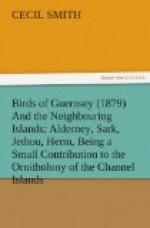Professor Ansted includes the Lesser Black-backed Gull in his list, but only marks it as occurring in Guernsey. There is one specimen in the Museum.
169. COMMON GULL. Larus canus, Linnaeus. French, “Goeland cendre,” “Mouette a pieds bleus,"[34] “La Mouette d’Hiver".[35]—The Common Gull, though by no means uncommon in the Channel Islands during the winter, never remains to breed there, nor does it do so, I believe, any where in the West of England, certainly not in Somerset or Devon, as stated by Mr. Dresser in the ‘Birds of Europe,’ fide the Rev. M.A. Mathew and Mr. W.D. Crotch, who must have made some mistake as to its breeding in those two counties; in Cornwall it is said to breed, by Mr. Dresser, on the authority of Mr. Rodd. Mr. Dresser, however, does not seem to have had his authority direct from either of these gentlemen, and only quotes it from Mr. A.G. More. Mr. Rodd, however, in his ’Notes on the Birds of Cornwall,’ published in the ‘Zoologist’ for 1870, only says, “Generally distributed in larger or smaller numbers along or near our coasts,” which would be equally true of the Channel Islands, although it does not breed there; however, as Mr. Rodd is going to publish his interesting notes on the Birds of Cornwall in a separate form, it is much to be hoped that he will clear that matter up as far as regards that county and the Scilly Islands. Like the Herring and Lesser Black-backed Gull, the Common Gull goes through several changes of plumage before it arrives at maturity; like them it begins with the mottled brownish stage, and gradually assumes the blue-grey mantle of maturity; in the earlier stages the primaries have no white spots at the tips. The legs and bill, which appear to go through more changes than in other Gulls, are in an intermediate state bluish grey (which accounts for Temminck’s name mentioned above) before they assume the pale yellow of maturity: although at this time they have the mantle quite as in the adult, there is a material difference in the pattern of the primary quills, and they do not appear to breed till their bills have become quite yellow and their legs a pale greenish yellow. I cannot quite tell at what age the Common Gull begins to breed, for, although I have a pair which have laid regularly for the last two years (they have not, however, hatched any young, which perhaps is the fault of the Herring Gulls, whom I have several times caught sucking their eggs), I do not know what their age was when I first had them as I did the Herring Gulls from Sark and the Lesser Black-backs from Burhou; I can only say when I first had them they had the bills and legs blue; in fact they were in the state in which they are the “Mouette a pieds bleus” of Temminck.
Professor Ansted includes the Common Gull in his list, and marks it as occurring in Guernsey and Sark. There is no specimen in the Museum.




